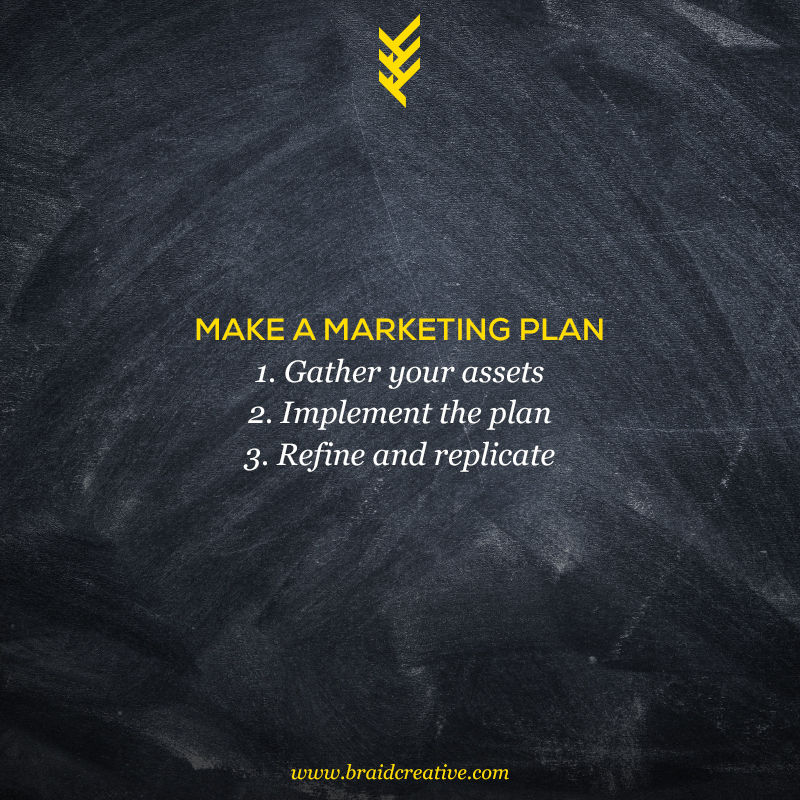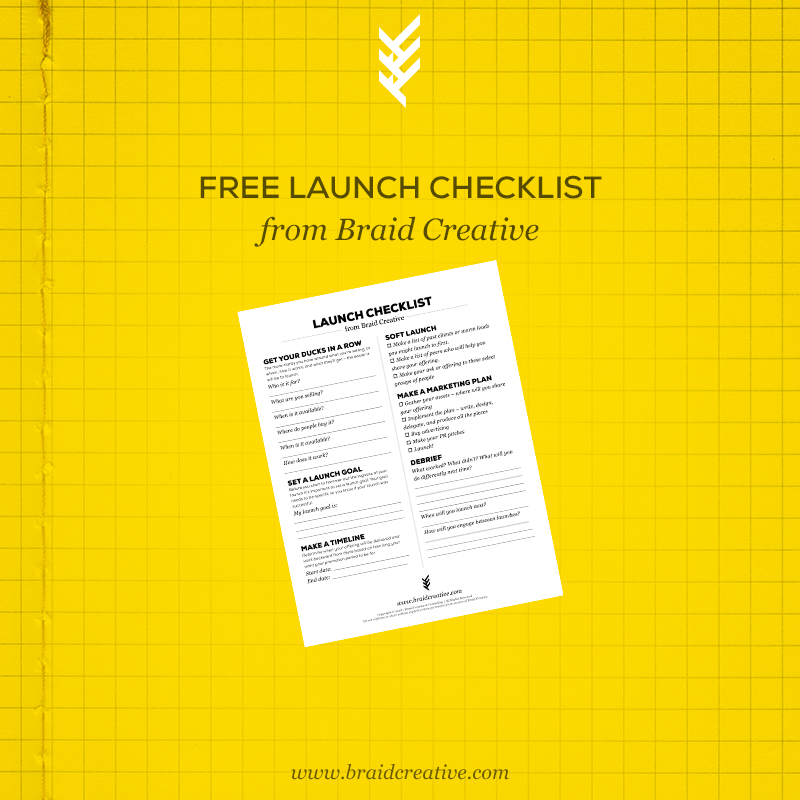“What do you know about launching? I need to do a proper launch … and I have no idea how to do it!”
Kathleen here and this is an actual cry for help I received from a Braid Method™ client. You see, what we’re best at is providing our clients—who are multi-layered organizations to purpose-driven businesses to creative entrepreneurs—a brand platform. This brand platform includes messaging, positioning, copy points, and a brand identity that they can then use in their marketing, advertising, and packaging. And as the name suggests, a platform is the place from which you launch – but you still gotta make the dive! So in this article, I will be detailing how to launch and create a marketing strategy for your new brand, product, service or offering.
By the way, this is a long and comprehensive post, but don’t get overwhelmed! Read through it and then download the launch checklist PDF I’ve made for you at the end of this post. No email required! But if you want to be sure to get these resources when they’re made available, we’d love it if you’d join our newsletter.
KNOW WHAT YOU’RE SELLING
Before you launch your business or offering, you need to make sure you know what you’re launching. The easiest way to do this is to go back to the “who, what, when, where, and why” you learned in grade school:
WHO – who is this business or offering for? Who is the dream customer that will benefit most from what you have to offer?
WHAT – what are you selling? The more specific you can get about what you’re offering, the better.
WHEN – When will your customer receive your offering? And if you’re offering has an incentive or limited time offer, when is it available for purchase?
WHERE – Where do people buy it? Where will people receive the product? Where can they find out more information?
HOW – How does it work? How will your customer receive the offering? How will it solve their problem?
The more clarity you have around what you’re selling, to whom, how it works, and what they’ll get – the easier it will be to launch.

SET A LAUNCH GOAL
Before you start to hammer out the logistics of your launch, it’s important to set a launch goal. Your goal needs to be specific so you know if your launch was successful. So it might look like a certain dollar amount, conversion rate, or number sold.
Your launch goal is also important because it will help guide some of the marketing decisions you make moving forward. For example, if your goal is to only sell ONE thing, then your launch might include a lot more high-touch efforts—like sending personalized videos or hosting 1:1 kickoff calls to warm prospects. If your goal is to sell LOTS of things, you might integrate an affiliate campaign or social media advertising into your plan.
MAKE A LAUNCH TIMELINE
Developing a marketing timeline for launching your offering is a bit of an art form. There is no one right way to do this so I’m going to share a general launch timeline, but you might adjust according to what works best for you. Also, be sure to think about the seasonality of your business and which time of year might be best for launching your offerings.
First, determine when your offering will be delivered and work backward from there based on how long your want your promotion period to be for. A lot of marketing professionals refer to this as a “cart open to cart closed” timeframe.
For example, let’s say you want a two week long marketing plan for your launch:
February 1 – offering is delivered to customer
January 31st – cart closed, offering is no longer available for purchase
January 30th – last chance to buy
January 20th – 30th – cart open, offering is available to everybody for purchase
January 18th-20th – early bird sale, offering is available to select groups for purchase
January 11th – soft launch to very select groups
I gave a two week example because I think it’s an ideal time frame. You give your customers enough time to consider your offering but it’s not so long that they get fatigued with your marketing. With a limited time window, you create a sense of urgency around purchasing your offering. Be sure to keep in mind that you’ll get most sales on the first and last days your offering is available for purchase – so make sure when you develop your marketing plan to really focus on those days. Also, be sure to leave lots of space in your own calendar (don’t overbook meetings or other deadlines) so you can be available for customer service, like answering questions for anyone who is interested during your launch.
By the way, if you have an evergreen (always available for purchase) offering, you can still have launch windows where you incentivize your audience with added value, bonus offerings, or discounts. Or maybe you’re simply doing a two-week long “push” around an offering, service, or product that is always available – where you’re focusing all of your marketing efforts around making your audience aware of how to buy you.
Finally, when it comes to your launch timeline, if you are able to build enough of a following and year round engagement in your brand, you can potentially get away with shorter timeframes down to 1-day long flash sales. You know your offering and audience best and context matters when it comes to your launch.
START WITH A SOFT LAUNCH
Before you begin shouting it from the rooftops, you should start with a soft launch. A soft launch is when you make your offering known or available to a select group, and I always recommend starting with the inside out.
Here’s what a soft launch might look like:
Let your existing clients know first with a personalized email or video message – it’s easiest to sell to people who already know and trust you and the quality of your work. The more you can individually reach out to people the better – this might look like a personalized email or even a quick video message letting them know about your launch. They might be a good fit or know someone who is – no matter what be sure to end on a clear call to action. Whether it’s telling them to “stay tuned for more information,” to share the launch with a friend who might benefit from it, or to buy it themselves.
Ask your peers to share – another way to launch from the inside out is to ask your inner circle of trusted peers, colleagues, or mastermind confidants to share the launch with you. The best way to do this is to create graphics and social media swipe copy that is all gathered in one place for easy sharing. Be specific about when and how you would like them to share. If you’re doing an affiliate program you could offer it to these folks as well.
After you hold a soft launch by letting your inner circle and existing customers know what you’re up to and now it’s time to get more eyes on what you have to offer. Now it’s time to make a splash!

MAKE A MARKETING PLAN
Once you’ve established the timeline of your launch now it’s time to make a marketing plan. A marketing plan is where you map out all of your marketing efforts across all of the places your brand shows up in a specific time frame in order to make an impact within the marketplace.
1. Gather your assets
The first thing you’ll want to do is gather all of the assets that you have and think about how your promotion will apply to each asset.
For example asset gathering might look like this:
Newsletter: I will send a series of 5 emails to my entire list during my launch
Signage: I will do a custom display in my storefront during my launch
Instagram: I will do a post a day plus interactive Instagram stories + chats during my launch
Community: I will do a live workshop in the Facebook Group I’m in during my launch
If you need help brainstorming all of your assets check out the branding checklist in this blog post here.
You can also market or advertise on other people’s platforms during a launch. This could include social media advertising, traditional advertising, and PR such as speaking gigs and podcast interviews. You will need to have quite a bit of lead time in order to buy space (if you’re doing some traditional advertising) or pitching for PR so be sure to account for that when it comes to your annual planning. For example, right now podcasts are really great way to reach new audiences and create new fans, but most podcasts record quite ahead of schedule and typically need between 2-4 months lead time to get you scheduled and recorded, in order to publish your episode in tandem with your launch.
2. Implement the plan
At this point you’ll want to implement the plan by writing the emails, nailing down the logistics, prepping for production, and tasking out the projects and delegating accordingly.
- Who is writing the copy?
- Who is designing the materials?
- Who is in charge of production?
- How is each piece being installed or published?
- What are the deadlines for all the components?
A marketing plan can be as simple or complex as you desire. If this is your first time to launch something, you might start simple and focus on your most effective assets. Then each time you launch your offering, add in one more marketing asset and see how it does. For example, if you’ve never hosted a webinar or a social media challenge AND this is your first launch you might be tackling too much.
3. Refine & replicate the plan
The great thing about a marketing plan is you can repeat it over and over again! Next time you launch you might layer in new tactics or eliminate ones that didn’t work but in general you can work smarter and not harder by replicating your previous plans. Be sure to consider how often you want to market your specific offering: monthly? Quarterly? Annually?
REMEMBER THAT YOU’RE A FARMER, NOT A HUNTER
It’s easy to go into a launch expecting to come out of it a millionaire – or at least a six-figure-aire. Now, I don’t want to burst any bubbles or be a Debbie Downer here, but I do want to manage expectations: those six-figure launches are typically the exception and not the rule – no matter how many Facebook ads you see promising that you too can get rich quick.
When you are launching a new offering, know that you are planting the seeds for many future launches and the more you can be consistent, learn and improve as you go the more you will see compounded returns on your investment in the future.
ENGAGING BETWEEN LAUNCHES
There is a time to sell and convert, and then there is a time to engage and share. In between your promotional periods and launches, it’s important to engage your audience, build their trust (and at the same time build your list). You can replicate your marketing campaign with a focus on engagement and growth – and while it’s not directly affecting your bottom line it’s an investment in your market that will reap the rewards when it’s time to sell again.
As promised, here is a launch checklist / worksheet that will help get you started. This is a direct download—you don’t even have to opt-in, but if you don’t want to miss our articles be sure to sign up for our newsletter and we’ll deliver our very best content straight to your inbox when it’s released.


